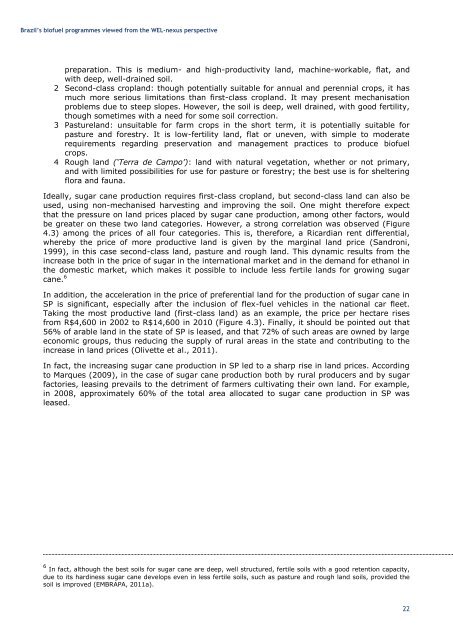Brazilian Biofuels Programmes from the WEL Nexus Perspective
Brazilian Biofuels Programmes from the WEL Nexus Perspective
Brazilian Biofuels Programmes from the WEL Nexus Perspective
- No tags were found...
You also want an ePaper? Increase the reach of your titles
YUMPU automatically turns print PDFs into web optimized ePapers that Google loves.
Brazil’s biofuel programmes viewed <strong>from</strong> <strong>the</strong> <strong>WEL</strong>-nexus perspectivepreparation. This is medium- and high-productivity land, machine-workable, flat, andwith deep, well-drained soil.2 Second-class cropland: though potentially suitable for annual and perennial crops, it hasmuch more serious limitations than first-class cropland. It may present mechanisationproblems due to steep slopes. However, <strong>the</strong> soil is deep, well drained, with good fertility,though sometimes with a need for some soil correction.3 Pastureland: unsuitable for farm crops in <strong>the</strong> short term, it is potentially suitable forpasture and forestry. It is low-fertility land, flat or uneven, with simple to moderaterequirements regarding preservation and management practices to produce biofuelcrops.4 Rough land (‘Terra de Campo’): land with natural vegetation, whe<strong>the</strong>r or not primary,and with limited possibilities for use for pasture or forestry; <strong>the</strong> best use is for shelteringflora and fauna.Ideally, sugar cane production requires first-class cropland, but second-class land can also beused, using non-mechanised harvesting and improving <strong>the</strong> soil. One might <strong>the</strong>refore expectthat <strong>the</strong> pressure on land prices placed by sugar cane production, among o<strong>the</strong>r factors, wouldbe greater on <strong>the</strong>se two land categories. However, a strong correlation was observed (Figure4.3) among <strong>the</strong> prices of all four categories. This is, <strong>the</strong>refore, a Ricardian rent differential,whereby <strong>the</strong> price of more productive land is given by <strong>the</strong> marginal land price (Sandroni,1999), in this case second-class land, pasture and rough land. This dynamic results <strong>from</strong> <strong>the</strong>increase both in <strong>the</strong> price of sugar in <strong>the</strong> international market and in <strong>the</strong> demand for ethanol in<strong>the</strong> domestic market, which makes it possible to include less fertile lands for growing sugarcane. 6In addition, <strong>the</strong> acceleration in <strong>the</strong> price of preferential land for <strong>the</strong> production of sugar cane inSP is significant, especially after <strong>the</strong> inclusion of flex-fuel vehicles in <strong>the</strong> national car fleet.Taking <strong>the</strong> most productive land (first-class land) as an example, <strong>the</strong> price per hectare rises<strong>from</strong> R$4,600 in 2002 to R$14,600 in 2010 (Figure 4.3). Finally, it should be pointed out that56% of arable land in <strong>the</strong> state of SP is leased, and that 72% of such areas are owned by largeeconomic groups, thus reducing <strong>the</strong> supply of rural areas in <strong>the</strong> state and contributing to <strong>the</strong>increase in land prices (Olivette et al., 2011).In fact, <strong>the</strong> increasing sugar cane production in SP led to a sharp rise in land prices. Accordingto Marques (2009), in <strong>the</strong> case of sugar cane production both by rural producers and by sugarfactories, leasing prevails to <strong>the</strong> detriment of farmers cultivating <strong>the</strong>ir own land. For example,in 2008, approximately 60% of <strong>the</strong> total area allocated to sugar cane production in SP wasleased.6 In fact, although <strong>the</strong> best soils for sugar cane are deep, well structured, fertile soils with a good retention capacity,due to its hardiness sugar cane develops even in less fertile soils, such as pasture and rough land soils, provided <strong>the</strong>soil is improved (EMBRAPA, 2011a).22
















